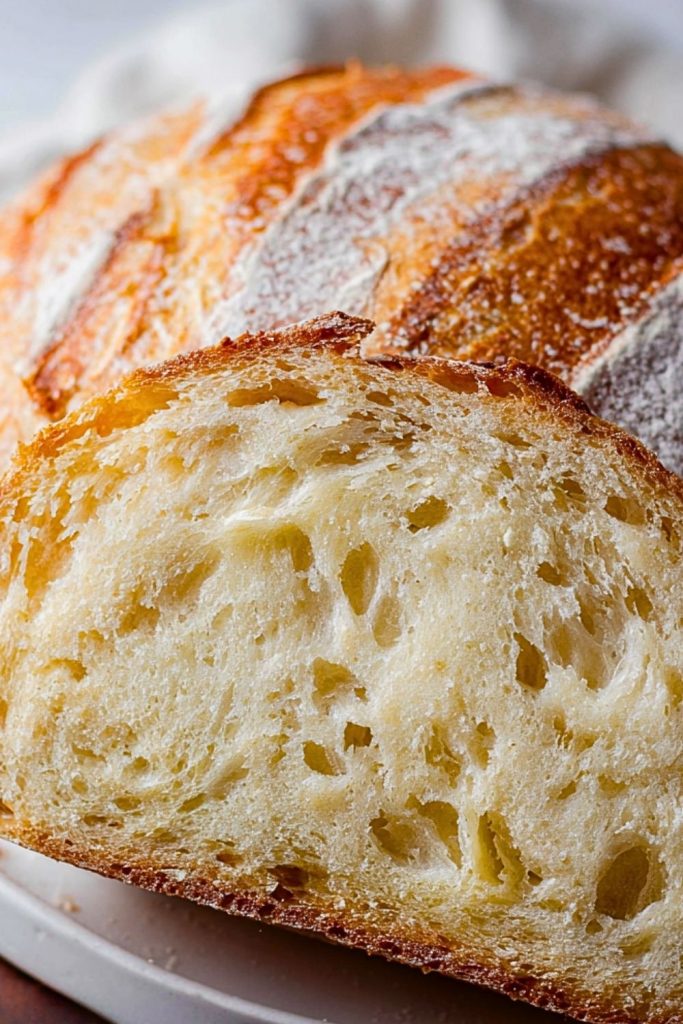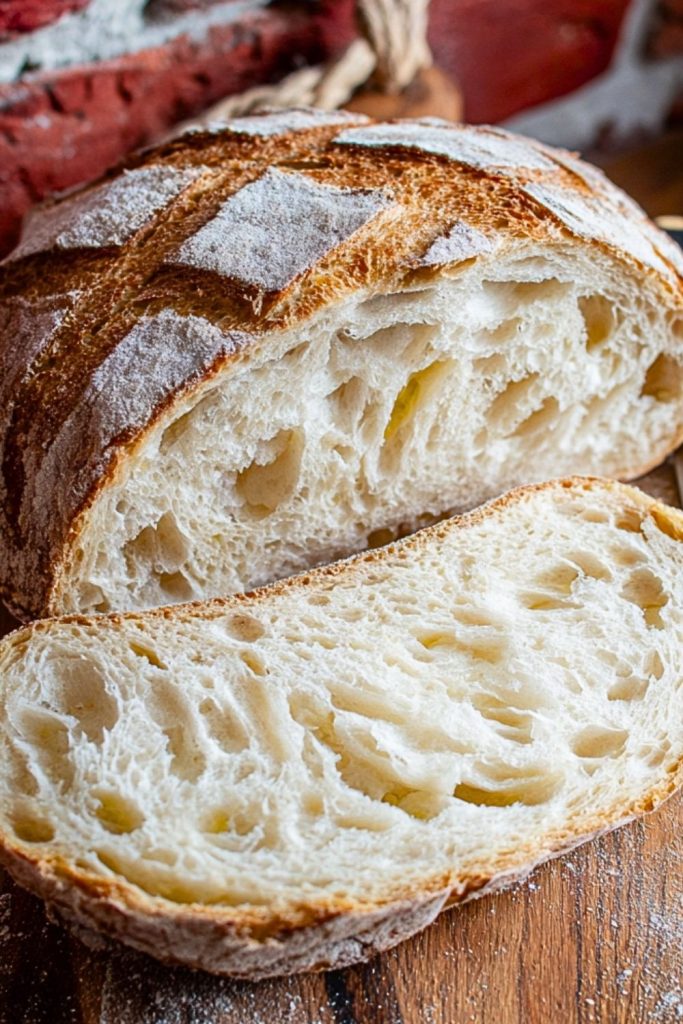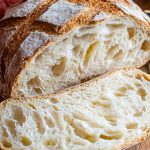I’ve baked a lot of bread over the years, but this sourdough loaf still fills me with joy every time I slice into it. It’s rustic, golden on the outside, airy and chewy on the inside — and it carries that unmistakable tang only sourdough can offer. What makes it even more satisfying is that it all starts with just a few ingredients and a bit of patience. The end result? A beautiful artisan-style loaf that looks (and tastes) like it came from a bakery.

I love the process of sourdough. It invites you to slow down, to connect with your food, and to understand fermentation and time in a completely different way. Every loaf feels like a little accomplishment. Whether you’re brand new to baking or looking to perfect your sourdough game, this recipe is forgiving, rewarding, and so delicious.
Why You’ll Love This Sourdough Bread Recipe
- Incredible Flavor: That slight sourness paired with a toasty crust is just unbeatable.
- Perfect Texture: Expect a crusty, golden exterior with a soft, airy interior full of beautiful holes.
- No Commercial Yeast: All-natural fermentation from your own starter means fewer ingredients and more nutrition.
- Beginner-Friendly: You don’t need fancy tools or a professional setup — just basic ingredients, time, and your hands.
- Endlessly Versatile: Eat it with butter, dip it in soup, turn it into toast — this loaf is a staple you’ll use every day.
What Kind of Flour Should I Use for Sourdough Bread?
The best sourdough starts with the right flour. I like to use a combination of bread flour and a bit of whole wheat flour. Bread flour gives the loaf its chewy, structured crumb thanks to the high protein content, while whole wheat flour adds depth and a nuttier flavor. You can absolutely use all bread flour if you prefer a more classic texture, or play around with adding rye or spelt for a rustic touch. Just remember: different flours absorb water differently, so hydration levels might need adjusting slightly.
Options for Substitutions
- Flour: Swap whole wheat flour for spelt, rye, or even all-purpose if you’re in a pinch — though the flavor and texture will shift a bit.
- Sourdough Starter: If your starter is new and not super strong yet, try feeding it with bread flour to boost activity.
- Salt: I prefer fine sea salt for even distribution, but kosher salt works too. Just measure by weight if possible.
- Water: Filtered water is ideal, especially if your tap water is heavily chlorinated, which can affect fermentation.
- Add-ins: Want a twist? Fold in roasted garlic, herbs, seeds, or cheese during your stretch-and-folds to add character to your loaf.
Ingredients for This Sourdough Bread Recipe
Bread Flour
The backbone of the dough, bread flour has a high protein content which gives sourdough its chewy texture and strong gluten structure.
Whole Wheat Flour
Just a small percentage adds complexity and a subtle earthiness that makes the flavor more rounded and deep.
Water
Hydration is key in sourdough. Water activates the flour, supports gluten formation, and fuels the fermentation process.
Sourdough Starter (Active and Bubbly)
This is your natural leavening agent. It brings both rise and that iconic tangy flavor. Make sure it’s been recently fed and is at its peak activity.
Salt
Essential not just for flavor, but also to help strengthen the dough structure and regulate fermentation.

Step 1: Mix the Dough
In a large bowl, mix your flours and water until no dry bits remain. Let it rest for 30 minutes — this is the autolyse phase, which helps gluten development naturally before salt or starter is added.
Step 2: Add Starter and Salt
Add your bubbly sourdough starter and salt to the dough. Mix thoroughly by hand until everything is well incorporated. The dough will feel sticky, but that’s normal.
Step 3: Bulk Fermentation with Stretch and Folds
Cover the bowl and let the dough rise at room temperature. During the first 2-3 hours, perform stretch-and-folds every 30 minutes — gently lift one side of the dough and fold it over itself. This strengthens the dough while keeping your hands off the mixer.
Step 4: Pre-Shape and Rest
Once bulk fermentation is complete and your dough has risen and become airy, turn it out onto a lightly floured surface. Shape it gently into a round, let it rest for 20–30 minutes uncovered.
Step 5: Final Shape and Cold Proof
Reshape into a tight round loaf and place into a floured banneton or bowl lined with a towel. Cover and refrigerate overnight for cold fermentation — this step enhances flavor and texture.
Step 6: Score and Bake
Preheat your oven with a Dutch oven inside. Once it’s hot, carefully turn your dough out onto parchment paper, score the top with a razor or sharp knife, and bake covered at high heat, then uncovered for a beautifully browned crust.
How Long to Cook the Sourdough Bread
Bake your sourdough loaf at 475°F (245°C) for 20 minutes with the lid on (if using a Dutch oven), then remove the lid and continue baking for another 20–25 minutes until the crust is deep golden brown. The internal temperature should be around 208–210°F (97–99°C) when it’s fully baked.
Tips for Perfect Sourdough Bread
- Use a Mature Starter: Your starter should be active, bubbly, and pass the float test before mixing your dough.
- Be Patient with Fermentation: Don’t rush bulk fermentation — the dough should expand noticeably and feel pillowy.
- Wet Your Hands: When handling sticky dough, damp hands prevent sticking without adding more flour.
- Score with Confidence: A deep, clean score helps the loaf expand properly in the oven.
- Let It Cool: Resist cutting into the bread while it’s hot — it needs at least an hour to cool and finish setting inside.
Watch Out for These Mistakes While Cooking
- Using an Underfed Starter: If your starter isn’t active, your dough won’t rise properly and will lack flavor.
- Skipping the Rest Periods: Autolyse and bench rest help with structure — don’t rush through them.
- Overproofing: Leaving the dough too long in bulk or final proof can cause it to collapse. Watch the dough, not the clock.
- Too Much Flour While Shaping: This can prevent proper surface tension, which is key for oven spring.
- Not Preheating the Oven Enough: A hot Dutch oven is critical for creating steam and a crisp crust.
What to Serve With Sourdough Bread?
Olive Oil and Balsamic Vinegar
A simple dip that lets the bread’s flavor shine through.
Softened Salted Butter
The classic pairing — especially when the loaf is still slightly warm.
Creamy Brie or Camembert
Rich, gooey cheeses complement the tang of sourdough beautifully.
Tomato Basil Soup
A warm bowl of this classic soup with crusty sourdough is pure comfort.
Avocado and Poached Egg
Top slices with creamy avocado and a jammy egg for a nutritious breakfast.
Roasted Garlic Spread
Mash roasted garlic into butter or olive oil for a flavorful spread.
Smoked Salmon and Cream Cheese
Makes for an elegant, brunch-style open-faced sandwich.
Hummus and Cucumber
A refreshing, plant-based topping perfect for a light snack or lunch.
Storage Instructions
Sourdough bread stays freshest stored at room temperature, loosely wrapped in a clean kitchen towel or in a bread bag. Avoid plastic bags — they trap moisture and make the crust soft. It’s best eaten within 2–3 days, but you can refresh it by toasting slices or popping the whole loaf in a warm oven for a few minutes.
To store longer, slice the bread and freeze it in a sealed bag. Toast slices straight from the freezer — they come out perfectly. Avoid refrigerating the loaf, as this tends to dry it out faster than storing at room temperature or freezing.
Estimated Nutrition
Per slice (based on 12 slices per loaf)
- Calories: 160
- Carbohydrates: 30g
- Protein: 5g
- Fat: 0.5g
- Fiber: 2g
- Sugar: 0g
- Sodium: 300mg
Note: Nutrition will vary slightly depending on flour types and starter hydration.
Frequently Asked Questions
How do I know when my sourdough starter is ready to use?
It should double in size within 4–6 hours after feeding, look bubbly, and pass the float test — a spoonful should float in water.
Can I make this bread without a Dutch oven?
Yes, you can bake on a pizza stone with a tray of water in the oven to create steam, though the crust won’t be as crisp.
How do I fix a dough that’s too wet or sticky?
Try doing an extra set of stretch and folds instead of adding flour. Over time, the dough will strengthen and become more manageable.
Why didn’t my sourdough rise well?
Your starter might have been weak, or the dough over-proofed. Temperature and timing are key — always monitor the dough.
Can I add seeds or nuts to the dough?
Absolutely! Fold them in after the first stretch-and-fold. Toasting them beforehand enhances their flavor.
How long can I keep the dough in the fridge before baking?
You can cold-proof it for up to 36 hours. Longer proofing deepens the flavor but watch that it doesn’t over-ferment.
Is it okay if my crust gets too hard?
Try baking at a slightly lower temp during the uncovered phase, or wrap the hot loaf in a towel to soften the crust slightly.
Can I use whole wheat flour only?
You can, but the dough will be denser and need more hydration. Start with a small percentage and work your way up if you like a heartier loaf.
Conclusion
Baking sourdough bread is more than just a recipe — it’s a ritual. It takes time, attention, and a bit of trial and error, but once you get into the rhythm, it’s deeply satisfying. This loaf is crusty, chewy, and just tangy enough to keep you coming back for another slice. Whether you’re buttering it fresh out of the oven or toasting it for breakfast, you’ll feel the reward in every bite.

The Best Sourdough Bread Recipe
- Prep Time: 30 minutes
- Cook Time: 45 minutes
- Total Time: 1 hour 15 minutes
- Yield: 1 large loaf 1x
Description
A rustic, artisan-style sourdough bread with a crisp crust, chewy crumb, and tangy flavor. Naturally leavened with an active sourdough starter, this loaf is perfect for both beginners and seasoned bakers who enjoy the rewarding process of fermentation.
Ingredients
- 400g bread flour
- 100g whole wheat flour
- 375g water (filtered)
- 100g active sourdough starter
- 10g sea salt
Instructions
- Mix bread flour, whole wheat flour, and water until no dry bits remain. Let rest for 30 minutes (autolyse).
- Add sourdough starter and salt. Mix until fully incorporated.
- Cover and let rise at room temperature, performing stretch-and-folds every 30 minutes during the first 2-3 hours.
- After bulk fermentation (about 4-6 hours total), pre-shape the dough on a floured surface. Let rest 20–30 minutes.
- Final shape into a round loaf. Place into a floured banneton or towel-lined bowl. Cover and refrigerate overnight.
- Preheat oven with Dutch oven inside to 475°F (245°C).
- Turn dough onto parchment, score the top, and bake covered for 20 minutes. Uncover and bake another 20–25 minutes.
- Let cool completely on a wire rack before slicing.

